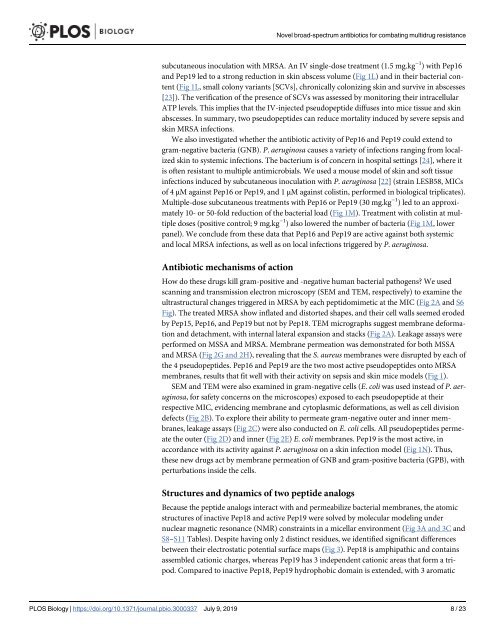Novel antibiotics effective against grampositive and -negative multi-resistant bacteria with limited resistance
Antibiotics are a medical wonder, but an increasing frequency of resistance among most human pathogens is rendering them ineffective. If this trend continues, the consequences for public health and for the general community could be catastrophic. The current clinical pipeline, however, is very limited and is dominated by derivatives of established classes, the “me too” compounds.
Antibiotics are a medical wonder, but an increasing frequency of resistance among most human pathogens is rendering them ineffective. If this trend continues, the consequences for public health and for the general community could be catastrophic. The current clinical pipeline, however, is very limited and is dominated by derivatives of established classes, the “me too” compounds.
You also want an ePaper? Increase the reach of your titles
YUMPU automatically turns print PDFs into web optimized ePapers that Google loves.
<strong>Novel</strong> broad-spectrum <strong>antibiotics</strong> for combating <strong>multi</strong>drug <strong>resistance</strong><br />
subcutaneous inoculation <strong>with</strong> MRSA. An IV single-dose treatment (1.5 mg.kg −1 ) <strong>with</strong> Pep16<br />
<strong>and</strong> Pep19 led to a strong reduction in skin abscess volume (Fig 1L) <strong>and</strong> in their <strong>bacteria</strong>l content<br />
(Fig 1L, small colony variants [SCVs], chronically colonizing skin <strong>and</strong> survive in abscesses<br />
[23]). The verification of the presence of SCVs was assessed by monitoring their intracellular<br />
ATP levels. This implies that the IV-injected pseudopeptide diffuses into mice tissue <strong>and</strong> skin<br />
abscesses. In summary, two pseudopeptides can reduce mortality induced by severe sepsis <strong>and</strong><br />
skin MRSA infections.<br />
We also investigated whether the antibiotic activity of Pep16 <strong>and</strong> Pep19 could extend to<br />
gram-<strong>negative</strong> <strong>bacteria</strong> (GNB).P.aeruginosa causes a variety of infections ranging from localized<br />
skin to systemic infections. The bacterium is of concern in hospital settings [24], where it<br />
is often <strong>resistant</strong> to <strong>multi</strong>ple antimicrobials. We used a mouse model of skin <strong>and</strong> soft tissue<br />
infections induced by subcutaneous inoculation <strong>with</strong>P.aeruginosa [22] (strain LESB58, MICs<br />
of 4μM <strong>against</strong> Pep16 or Pep19, <strong>and</strong> 1μM <strong>against</strong> colistin, performed in biological triplicates).<br />
Multiple-dose subcutaneous treatments <strong>with</strong> Pep16 or Pep19 (30 mg.kg −1 ) led to an approximately<br />
10- or 50-fold reduction of the <strong>bacteria</strong>l load (Fig 1M). Treatment <strong>with</strong> colistin at <strong>multi</strong>ple<br />
doses (positive control; 9 mg.kg −1 ) also lowered the number of <strong>bacteria</strong> (Fig 1M, lower<br />
panel). We conclude from these data that Pep16 <strong>and</strong> Pep19 are active <strong>against</strong> both systemic<br />
<strong>and</strong> local MRSA infections, as well as on local infections triggered byP.aeruginosa.<br />
Antibiotic mechanisms of action<br />
How do these drugs kill gram-positive <strong>and</strong> -<strong>negative</strong> human <strong>bacteria</strong>l pathogens? We used<br />
scanning <strong>and</strong> transmission electron microscopy (SEM <strong>and</strong> TEM, respectively) to examine the<br />
ultrastructural changes triggered in MRSA by each peptidomimetic at the MIC (Fig 2A <strong>and</strong> S6<br />
Fig). The treated MRSA show inflated <strong>and</strong> distorted shapes, <strong>and</strong> their cell walls seemed eroded<br />
by Pep15, Pep16, <strong>and</strong> Pep19 but not by Pep18. TEM micrographs suggest membrane deformation<br />
<strong>and</strong> detachment, <strong>with</strong> internal lateral expansion <strong>and</strong> stacks (Fig 2A). Leakage assays were<br />
performed on MSSA <strong>and</strong> MRSA. Membrane permeation was demonstrated for both MSSA<br />
<strong>and</strong> MRSA (Fig 2G <strong>and</strong> 2H), revealing that theS.aureus membranes were disrupted by each of<br />
the 4 pseudopeptides. Pep16 <strong>and</strong> Pep19 are the two most active pseudopeptides onto MRSA<br />
membranes, results that fit well <strong>with</strong> their activity on sepsis <strong>and</strong> skin mice models (Fig 1).<br />
SEM <strong>and</strong> TEM were also examined in gram-<strong>negative</strong> cells (E.coli was used instead ofP.aeruginosa,<br />
for safety concerns on the microscopes) exposed to each pseudopeptide at their<br />
respective MIC, evidencing membrane <strong>and</strong> cytoplasmic deformations, as well as cell division<br />
defects (Fig 2B). To explore their ability to permeate gram-<strong>negative</strong> outer <strong>and</strong> inner membranes,<br />
leakage assays (Fig 2C) were also conducted onE.coli cells. All pseudopeptides permeate<br />
the outer (Fig 2D) <strong>and</strong> inner (Fig 2E)E.coli membranes. Pep19 is the most active, in<br />
accordance <strong>with</strong> its activity <strong>against</strong>P.aeruginosa on a skin infection model (Fig 1N). Thus,<br />
these new drugs act by membrane permeation of GNB <strong>and</strong> gram-positive <strong>bacteria</strong> (GPB), <strong>with</strong><br />
perturbations inside the cells.<br />
Structures <strong>and</strong> dynamics of two peptide analogs<br />
Because the peptide analogs interact <strong>with</strong> <strong>and</strong> permeabilize <strong>bacteria</strong>l membranes, the atomic<br />
structures of inactive Pep18 <strong>and</strong> active Pep19 were solved by molecular modeling under<br />
nuclear magnetic resonance (NMR) constraints in a micellar environment (Fig 3A <strong>and</strong> 3C <strong>and</strong><br />
S8–S11 Tables). Despite having only 2 distinct residues, we identified significant differences<br />
between their electrostatic potential surface maps (Fig 3). Pep18 is amphipathic <strong>and</strong> contains<br />
assembled cationic charges, whereas Pep19 has 3 independent cationic areas that form a tripod.<br />
Compared to inactive Pep18, Pep19 hydrophobic domain is extended, <strong>with</strong> 3 aromatic<br />
PLOS Biology | https://doi.org/10.1371/journal.pbio.3000337 July 9, 2019 8 / 23


















